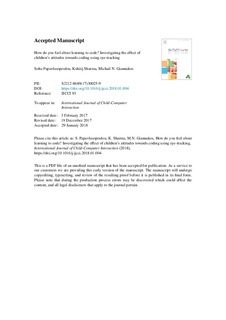| dc.contributor.author | Papavlasopoulou, Sofia | |
| dc.contributor.author | Sharma, Kshitij | |
| dc.contributor.author | Giannakos, Michail | |
| dc.date.accessioned | 2018-02-28T07:43:17Z | |
| dc.date.available | 2018-02-28T07:43:17Z | |
| dc.date.created | 2018-02-04T17:35:27Z | |
| dc.date.issued | 2018 | |
| dc.identifier.issn | 2212-8689 | |
| dc.identifier.uri | http://hdl.handle.net/11250/2487524 | |
| dc.description.abstract | Computational thinking and coding for children are attracting increasing attention. There are several efforts around the globe to implement coding frameworks for children, and there is a need to develop an empirical knowledge base of methods and tools. One major problem for integrating study results into a common body of knowledge is the relatively limited measurements applied, and the relation of the widely used self-reporting methods with more objective measurements, such as biophysical ones. In this study, eye-tracking activity was used to measure children’s learning and activity indicators. The goal of the study is to utilize eye-tracking to understand children’s activity while they learn how to code and to investigate any potential association between children’s attitudes and their gaze. In this contribution, we designed an experiment with 44 children (between 8 and 17 years old) who participated in a full-day construction-based coding activity. We recorded their gaze while they were working and captured their attitudes in relation to their learning, excitement and intention. The results showed a significant relation between children’s attitudes (what they think about coding) and their gaze patterns (how they behaved during coding). Eye-tracking data provide initial insights into the behaviour of children, for example if children have difficulty in extracting information or fail to accomplish an expected task. Therefore, further studies need to be conducted to shed additional light on children’s experience and learning duringcoding. | nb_NO |
| dc.language.iso | eng | nb_NO |
| dc.publisher | Elsevier | nb_NO |
| dc.rights | Attribution-NonCommercial-NoDerivatives 4.0 Internasjonal | * |
| dc.rights.uri | http://creativecommons.org/licenses/by-nc-nd/4.0/deed.no | * |
| dc.title | How do you feel about learning to code? Investigating the effect of children’s attitudes towards coding using eye-tracking | nb_NO |
| dc.type | Journal article | nb_NO |
| dc.type | Peer reviewed | nb_NO |
| dc.description.version | acceptedVersion | nb_NO |
| dc.source.journal | International Journal of Child-Computer Interaction | nb_NO |
| dc.identifier.doi | 10.1016/j.ijcci.2018.01.004 | |
| dc.identifier.cristin | 1561602 | |
| dc.relation.project | NOKUT (Nasjonalt organ for kvalitet i utdanningen): 528526 | nb_NO |
| dc.relation.project | Norges forskningsråd: 255129 | nb_NO |
| dc.description.localcode | © 2018. This is the authors’ accepted and refereed manuscript to the article. Locked until 3.2.2020 due to copyright restrictions. This manuscript version is made available under the CC-BY-NC-ND 4.0 license http://creativecommons.org/licenses/by-nc-nd/4.0/ | nb_NO |
| cristin.unitcode | 194,63,10,0 | |
| cristin.unitname | Institutt for datateknologi og informatikk | |
| cristin.ispublished | true | |
| cristin.fulltext | postprint | |
| cristin.qualitycode | 1 | |

